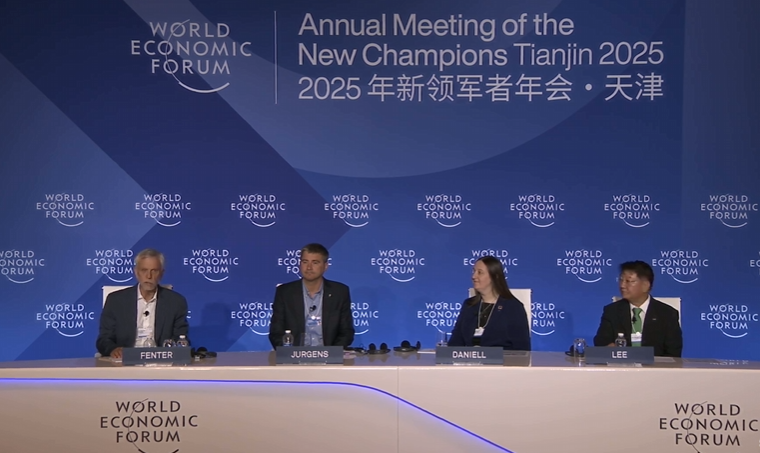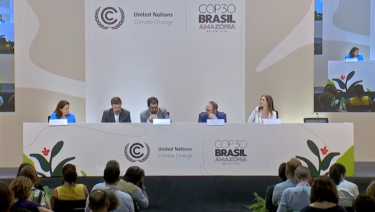Autonomous Biochemical Sensing can turn human bodies into surveillance tools for monitoring and control, Collaborative Sensing has the potential to do the same for entire cities: perspective
The World Economic Forum (WEF) Annual Meeting of the New Champions (AMNC), aka “Summer Davos,” kicks off in China with the launch of the “Top 10 Emerging Technologies of 2025” report, which includes sensors connected to the internet that would continuously surveil humans and cities, inside and out.
For over a decade, the WEF has been putting out emerging tech reports, and this year’s top 10 include:
- Structural battery composites: Merging energy and engineering in motion
- Osmotic power systems: Channeling salt into energy
- Advanced nuclear technologies: Bringing next-generation nuclear to power progress
- Engineered living therapeutics: Microbes designed to deliver therapies on demand
- GLP-1s for neurodegenerative disease: Activating brain pathways for longer, healthier lives
- Autonomous biochemical sensing: Wiring biological sensors for real-time insight
- Green nitrogen fixation: Reimagining ammonia production for a net-zero future
- Nanozymes: Replicating nature’s catalysts for health and environmental breakthroughs
- Collaborative sensing: Empowering connected systems to make context-aware decisions
- Generative watermarking: Enhancing trust with invisible, immutable markers
Here, we shall focus on the two technologies that have to do with sensing, as they also have to do with total surveillance over the human population — from the Internet of Bodies (IoB) ecosystem of devices that can be worn, implanted, or ingested to smart cities that track-and-trace every movement.
Let’s start with autonomous biochemical sensing.
“While typical sensors, such as well-known COVID-19 tests, are single-use, the challenge in autonomous biochemical sensing is to achieve continuous monitoring and electronic data capture”
WEF, Top 10 Emerging Technologies of 2025, June 2025
The idea behind autonomous biochemical sensing is to monitor everything that goes on inside the human body and other natural environments.
The technology has the potential to detect illnesses before they occur, to administer therapeutics automatically into the body when needed, and this type of sensing can be used in food safety processing and environmental monitoring.
One example given in the report includes US-based Persperity Health, which “is developing wearables for continuous monitoring of female hormones for ovulation tracking, fertility treatments and menopause care.”
Another example says that early detection of contaminants “could also lead to significant social and environmental benefits.”
But at the same time, autonomous biochemical sensing could turn your body into a surveillance lab for the state or a corporation to monitor and control.
Think of the contact tracing, vaccine passports, and mass testing that was conducted during lockdowns.
Now, imagine that all of that was done autonomously, without the need to download an app, without the need to show proof of a negative test, without the need to show proof of vaccination.
None of that would be necessary because there’d be sensors on and under your skin that would be sending all that information to the government or corporation in real-time.
As the WEF report describes the autonomous biochemical sensors:
“These sensors are designed to operate and report findings independently, without the need for human intervention.
“They employ wireless communication and energy harvesting, through self-sustaining power sources such as biofuel cells, to enable real-time continuous monitoring.
“As data from these sensors can be retrieved remotely, they are suitable for applications in difficult-to-reach areas or remote locations.
“This enables the continuous monitoring of human health as well as environmental conditions.”
The “continuous monitoring of human health” could also become a doctor-patient confidentiality minefield as private health data would seamlessly flow between public and private entities in real-time, automatically.
“The decentralization of diagnostics through wearable and point-of-care biosensors would extend testing capabilities beyond traditional healthcare facilities into homes and remote communities”
WEF, Top 10 Emerging Technologies of 2025, June 2025
In addressing data and privacy issues, the report says:
“As autonomous sensing networks generate continuous molecular information across multiple domains, the resulting data streams will require new analytical frameworks and governance models.
“The privacy and security implications, particularly for health-related sensing, demand regulatory approaches that balance innovation with the protection of sensitive information.”
In other words, laws would have to be changed, or you’d have to otherwise give up your rights voluntarily for a promise of better health outcomes.
And as a messaging strategy to lull the public into accepting the complete and total invasion of privacy and bodily autonomy, the WEF report suggests that stakeholders should:
“Conduct public demonstrations of non-invasive applications” that would “showcase environmental and agricultural applications of biochemical sensing to build public comfort with the technology before expanding to healthcare use.”
And in keeping with the “One Health” agenda, the climate, the environment, wild animals, and human health are all considered to be interconnected, which provides the perfect cover to ensure that everything in nature, and every person on the planet is to be tracked-and-traced in real-time.
“Organizations that successfully implement autonomous biochemical sensing will likely move beyond applying these technologies to isolated problems and instead develop interconnected monitoring networks that share data across traditional boundaries.
WEF, Top 10 Emerging Technologies of 2025, June 2025
“This integration would create new capabilities: environmental contaminants could be traced to their source and linked to potential health impacts in real-time; foodborne pathogens might be detected and contained before reaching consumers; and early disease indicators could trigger preventive interventions before symptoms appear”
Now that we’ve seen how the WEF frames tracking-and-tracing everything in nature — including everything that goes on inside your body — as something for the greater good, let’s take a look at the other sensing technology in the emerging tech report: collaborative sensing.
If you thought cameras on every corner and schemes like congesting fees in New York or Ultra Low Emission Zone (ULEZ) fines in the UK were intrusive and needlessly penalizing, what until you hear about collaborative sensing!
“Autonomous agents, such as robots, drones, intelligent vehicles and IT systems, with semantic reasoning and dynamic planning capabilities, will be equipped to navigate unfamiliar environments and make collective decisions”
WEF, Top 10 Emerging Technologies of 2025, June 2025
According to the report, “Sensing devices are now ubiquitous in people’s homes, vehicles and workplaces.”
Right off the bat, this type messaging normalizes surveillance as something we already accept in order to sell us on more surveillance that is technologically far beyond anything we’ve ever experienced.
In the future, the authors say that “Collaborative sensing will reshape how cities operate and how organizations use information to make decisions.”
If that’s true, then collaborative sensing would almost certainly have to apply law enforcement as well.
CCTV cameras are child’s play to what’s in store for the future.
While the WEF emerging tech report makes no mention of how collaborative sensing could combat crime, take a look at the following excerpts and imagine how law enforcement would salivate at the idea of wielding these capabilities:
- “The key to unlocking the benefits of collaborative sensing at scale and achieving true collaborative autonomy, will be multi-modal algorithms that can process numerous varieties of sensor data, from LiDAR (light detection and ranging) to EO/IR (electro-optical/infra-red) cameras to radar and beyond.”
- “Collaborative sensing could significantly reshape urban systems, mobility and societal infrastructure. Powered by vehicle-to-everything (V2X) technologies, 5G, AI and edge computing, this approach may create intelligent urban environments that perceive, respond and adapt to complex environmental dynamics with greater precision than current systems.”
- “Autonomous agents, such as robots, drones, intelligent vehicles and IT systems, with semantic reasoning and dynamic planning capabilities, will be equipped to navigate unfamiliar environments and make collective decisions”
Imagine a city patrolled by autonomous robots and drones powered by vehicle-to-everything technologies that can deploy LiDAR and infra-red sensing that can see into every home, vehicle, and underground structure.
There would be nowhere to hide.
Of course, the WEF report paints collaborative sensing as being just a way make cities and other environments more resilient by providing better emergency response capabilities, better traffic management and urban mobility, improved health and safety outcomes, and lower carbon emissions.
For example, the authors say:
“The potential impact of collaborative sensing extends beyond traditional traffic management, reshaping urban resilience, supply chains and emergency response capabilities.
“Cities could develop adaptive infrastructures that respond in real time to changing conditions, enabling more dynamic resource allocation during crises, optimized delivery routes for critical supplies and coordinated emergency vehicle deployment.”
But just like how biochemical sensing can turn human bodies into surveillance tools for public and private entities to monitor and control, collaborative sensing has the potential to do the same for cities on a much greater scale.
The WEF Annual Meeting of the New Champions takes place in Tianjin, China from June 24-26.
Today’s panel on the “Top 10 Emerging Technologies of 2025” report dedicated about two-and-a-half minutes talking about “biochemical sensing” and “collaborative sensing.”
Image Source: YouTube screenshot of WEF Annual Meeting of the New Champions session on “Top 10 Emerging Technologies of 2025”












